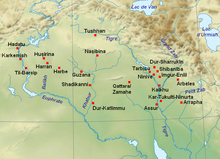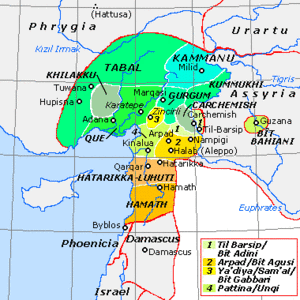Til Barsip
تل أحمر | |
 | |
| Alternative name | Masuwari, Tell Ahmar |
|---|---|
| Location | |
| Region | Aleppo Governorate |
| Coordinates | 36°40′26″N 38°07′16″E / 36.674°N 38.121°E |
| Type | Settlement |
| Area | 50 hectares (120 acres) |
| History | |
| Periods | Mittani, Assyrian |
| Site notes | |
| Condition | Ruins |
| Management | Directorate-General of Antiquities and Museums |
| Public access | Yes |

Til Barsip or Til Barsib (Hittite Masuwari,[1] modern Tell Ahmar; Arabic: تل أحمر) is an ancient site situated in Aleppo Governorate, Syria by the Euphrates river about 20 kilometers south of ancient Carchemish.
History
[edit]The site was inhabited as early as the Neolithic period with an important city, then called Abarsal, arising in Early Bronze III and being completely destroyed in EBIV.[2] It is the remains of the Iron Age city which is the most important settlement at Tell Ahmar. It was known in Hittite as Masuwari.[1][3] The city remained largely Neo-Hittite up to its conquest by the Neo-Assyrian Empire in the 856 BC and the Luwian language was used even after that.[4][5] Til Barsip was the capital of the Aramean-speaking Syro-Hittite state of Bît Adini. After being captured by the Assyrians from its previous king Ahuni,[6] the city was then renamed as Kar-Šulmānu-ašarēdu, after the Assyrian king Shalmaneser III, though its original name continued in use. It became a prominent center for the Assyrian administration of the region due to its strategic location at a crossing of the Euphrates river.
Til Barsip and Carchemish
[edit]After Til Barsip was occupied by Shalmaneser III, the important nearby city of Karkamish (Carchemish), only 20 km upstream the Euphrates river, remained under the rule of local kings of the House of Suhi. The Assyrian sources appear mostly silent about Karkamish until the mid-8th century BC. The only exception was a brief mention by Samši-Adad V (824–811 BC). The Assyrians may have left Karkamish alone either because of its strength, or because they profited from the extensive trade that the city conducted with many locations.[7]
Probably around 848 BC, the change of dynasty at Carchemish took place, and the House of Astiruwa started to rule. Carchemish was finally conquered by Sargon II in 717 BC.
Archaeology
[edit]
The tell was first excavated and examined by David George Hogarth,[8] who proposed the identification as Til Barsip.[9] Other than this research Hogarth was less interested with Tell Ahmar and Til Barsib and his only other discussion of the site is in a paper written in 1909 where it is only mentioned in name alone.[10]
The site was visited in 1909 by Gertrude Lowthian Bell who wrote about the town and also took photographs squeezes from some of the inscriptions and other finds there.[11][12] The site of Tell Ahmar was excavated by the French archaeologist François Thureau-Dangin from 1929 to 1931.[13][14] He uncovered the Iron Age city and an Early Bronze Age hypogeum burial with a large amount of pottery. Three important steles were also discovered at the site. These record how the 8th century BC Aramean king Bar Ga'yah, who may be identical with the Assyrian governor Shamshi-ilu, made a treaty with the city of Arpad. Recent excavations at Tell Ahmar were conducted by Guy Bunnens from the University of Melbourne in the late 1980s and through to the present.[15][16][17][18] Excavations ended in 2010.[19] Many ivory carvings of outstanding quality were discovered and these were published in 1997. Current excavations are under the auspices of the University of Liège, Belgium.[20]
Ahmar/Qubbah stele (Tell Ahmar 6)
[edit]Among the early Iron Age monuments discovered in the area was a particularly well-preserved stele known as the Ahmar/Qubbah stele, inscribed in Luwian,[17] which commemorates a military campaign by king de:Hamiyata of Masuwari around 900 BC. The stele also attests to the continued cult of the deity 'Tarhunzas of the Army', whom Hamiyatas is thought to have linked with Tarhunzas of Heaven and with the Storm-God of Aleppo.[21] This stele also indicates that the first king of Masuwari was named Hapatila, which may represent an old Hurrian name Hepa-tilla.
According to Woudhuizen, the name Hamiatas could also be understood as a Luwian reflection of Semitic Ammi-Ad(d)a (‘Hadad is my paternal uncle'), and Hapatilas as Abd-Ila ('servant of El').[5]
Hamiatas also set up some other Luwian hieroglyphic inscriptions. These are known as Tell Ahmar 2, 4 and 5, and Borowski 3. Hamiatas is also mentioned in an inscription Tell Ahmar 1 by one of his successors referred to as "Ariahinas’ son", as well as in the inscription Aleppo 2 by a confederate named Arpas.[5]
Kings of Masuwari
[edit]- Hapatilla
- Hamiyatas
- Bar Ga'yah
- Shamshi-ilu (governor)
See also
[edit]- Cities of the ancient Near East
- Short chronology timeline
- Euphrates Syrian Pillar Figurines
- Euphrates Handmade Syrian Horses and Riders
Notes
[edit]- ^ a b Hawkins, John D. Inscriptions of the Iron Age. Retrieved 7 Dec. 2010.
- ^ Astour, Michael C., "A Reconstruction of the History of Ebla (Part 2)", Eblaitica: Essays on the Ebla Archives and Eblaite Language, Volume 4, edited by Cyrus H. Gordon and Gary A. Rendsburg, University Park, USA: Penn State University Press, pp. 57-196, 2002
- ^ J. D. Hawkins, The Hittite Name of Til Barsip: Evidence from a New Hieroglyphic Fragment from Tell Ahmar, Anatolian Studies, vol. 33, Special Number in Honour of the Seventy-Fifth Birthday of Dr. Richard Barnett, pp. 131-136, 1983
- ^ J. D. Hawkins, The "Autobiography of Ariyahinas's Son": An Edition of the Hieroglyphic Luwian Stelae Tell Ahmar 1 and Aleppo 2, Anatolian Studies, vol. 30, Special Number in Honour of the Seventieth Birthday of Professor O. R. Gurney, pp. 139-156, 1980
- ^ a b c Fred C. Woudhuizen, The Recently Discovered Luwian Hieroglyphic Inscription from Tell Ahmar. Ancient West & East, vol. 9, pp. 1-19, 2010
- ^ Edward Lipiński, On the Skirts of Canaan in the Iron Age: Historical and Topographical Researches. Volume 153 of Orientalia Lovaniensia analecta, Peeters Publishers, 2006 ISBN 9042917989 p.216
- ^ J.D. Hawkins, M. Weeden (2016), Sketch history of Karkamish in the earlier Iron Age (Iron I–IIB). in Tony J. Wilkinson, Edgar Peltenburg 2016 (eds), CARCHEMISH IN CONTEXT - THE LAND OF CARCHEMISH PROJECT, 2006–2010. Oxbow Books, ISBN 1785701118 p.13
- ^ David George Hogarth: Carchemish and Its Neighbourhood. London 1909.
- ^ Carchemish and Its Neighbourhood. London 1909, 183
- ^ D. G. Hogarth, Recent Hittite Research, The Journal of the Royal Anthropological Institute of Great Britain and Ireland, vol. 39, pp. 408-415, 1909
- ^ Gertrude Lowthian Bell, The East Bank of the Euphrates from Tel Ahmar to Hit, The Geographical Journal, vol. 36, no. 5, pp. 513-537, 1910
- ^ [1] Gertrude Lowthian Bell, Amurath to Amurath, W. Heinemann, 1911
- ^ François Thureau-Dangin, Tell-Ahmar, Syria, vol. 10, iss. 10-3, pp. 185-205, 1929
- ^ F Thureau-Dangin; Maurice Dunand; Lucien Cavro; Georges Dossin, Til-Barsib, Paris : Paul Geuthner, 1936
- ^ Guy Bunnens, Tell Ahmar, 1988 Season, Ancient Near Eastern Studies Supplement Series, vol. 2, Peeters, 1990, ISBN 978-90-6831-322-2
- ^ Guy Bunnens, Melbourne University Excavations at Tell Ahmar on the Euphrates. Short Report on the 1989-1992 Seasons, Akkadica, no. 79-80, pp. 1-13, 1992
- ^ a b Bunnens, Guy; Hawkins, J.D.; Leirens, I. (2006). A New Luwian Stele and the Cult of the Storm-God at Til Barsib-Masuwari. Tell Ahmar II. Leuven: Publications de la Mission archéologique de l'Université de Liège en Syrie, Peeters. ISBN 978-90-429-1817-7.
- ^ A. Jamieson, Tell Ahmar III. Neo-Assyrian Pottery from Area C, Ancient Near Eastern Studies Supplement Series, vol. 35, Peeters, 2011, ISBN 978-90-429-2364-5
- ^ Guy Bunnens, A 3rd millennium temple at Tell Ahmar (Syria)_Proceedings of the 9th International Congress on the Archaeology of the Ancient Near East 3, Reports, ed. Oskar KAELIN & Hans-Peter MATHYS, Wiesbaden, pp. 187-198, 2016
- ^ Guy Bunnens, Tell Ahmar / Til Barsib, The Fourteenth and Fifteenth seasons (2001/2002), Orient Express, pp. 40-43, 2003
- ^ Bunnens, Guy (2006). "Religious Context". A New Luwian Stele and the Cult of the Storm-God at Til Barsib-Masuwari. Tell Ahmar II. Leuven: Publications de la Mission archéologique de l'Université de Liège en Syrie, Peeters. pp. 76–81. ISBN 978-90-429-1817-7.
References
[edit]- Guy Bunnens, "Carved ivories from Til Barsib", American Journal of Archaeology, vol. 101, no.3, pp. 435–450, (July 1997). Online version by JSTOR Archived 2006-11-11 at the Wayback Machine
- BUNNENS, Guy, "A STELA OF THE MOON GOD FROM TELL AHMAR/TIL BARSIB. CONTRIBUTION TO THE ICONOGRAPHY OF THE MOON GOD IN THE NEO-ASSYRIAN PERIOD", in Travels through the Orient and the Mediterranean World: Essays Presented to Eric Gubel, pp. 99–110, 2021
- Arlette Roobaert, "A Neo-Assyrian Statue from Til Barsib", Iraq, vol. 58, pp. 79–87, 1996
- Stephanie Dalley, "Neo-Assyrian Tablets from Til Barsib", Abr-Nahrain, vol. 34, pp. 66–99, 1996–1997
- Pierre Bordreuil and Françoise Briquel-Chatonnet, "Aramaic Documents from Til Barsip", Abr-Nahrain, vol. 34, pp. 100–107, 1996–1997
- [2] Sang, Li, "Burial practices of the third millennium BCE in the Middle Euphrates Region: an interpretation of funerary rituals", Unpublished PhD. Thesis, Tübingen, 2010
- R. Campbell Thompson, "Til-Barsip and Its Cuneiform Inscriptions", PSBA, vol. 34, pp. 66–74, 1912.
- Arlette Roobaert, "The Middle Bronze Age Funerary Evidence from Tell Ahmar (Syria)", Ancient Near Eastern Studies, vol. 35, pp. 97–105, 1998
- Max E.L. Mallowan, "The Syrian City of Til-Barsib", Antiquity, vol. 11, pp. 328–39, 1937


